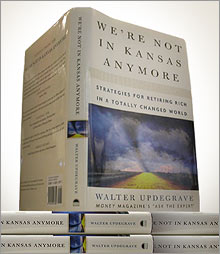|
Column Archive
Money Magazine Ask the Expert by Walter Updegrave
The 15 minute portfolio
I'm considering an investing strategy of equally dividing my money among three stock-index funds. Is this a good idea?
NEW YORK (CNNMoney.com) - I'm considering an investing strategy that recommends equally dividing your money among three stock-index funds -- one large-cap, one small-cap and one international. Do you think this is a good idea? -- Ryan G., Springfield, Virginia
Well, I like the simplicity of the approach (which makes it more likely you'll stick with it), as well as the focus on index funds (which keeps your costs down and returns up). And I think this strategy is certainly a better idea than devoting all your money to any one of those choices-or putting it in any single investment, for that matter. But I think I can help you do a lot better while still sticking to just three funds. Before I get to my recommendation, however, let me tell you what I don't like about the strategy you propose. Some downsides
First off, you're talking about investing solely in stocks. Yes, I know that stocks have historically delivered the highest long-term returns. And I believe they should be the largest holding of anyone investing for periods of, say, 10 years or longer. But just for basic diversification purposes, I believe virtually all investors should also hold some bonds. Hedging with some bonds will assure you're not totally dependent on one asset class. Similarly, if you ignore bonds altogether, your portfolio could really get hammered if the market takes a nasty turn south. One final quibble. Your stock position is pretty aggressive. You've got as much in small-caps as large-caps. In reality, investors as a whole hold only about 10 to 15 percent of their money in small-caps. That means you're making a much larger bet on small-caps than stock market investors overall. A suggestion
So what do I recommend instead? Simple. Just divide your money among three funds: a total stock market index fund, a total international stock-market index fund and a total bond market index fund. The total stock market index fund essentially gives you the entire U.S. stock market -- large-, mid- and small-caps -- all in one fund. Even better, you get each of these groups in the right proportions -- that is, the market value of large, medium and small stocks in the fund matches their respective market values in the market. The bond index fund does pretty much the same for your bond exposure -- you buy the entire bond market -- while the international fund gives you access to a broad array of international stocks in one portfolio. For specific funds you can buy to follow this strategy, I suggest you check out the index-fund listings in the MONEY 65, Money Magazine's elite list of recommended funds. Allocation
That still leaves the question of how to spread your money among the three funds -- how much goes into the total stock market index, how much into the international index and how much into bonds? The answer depends on two things: your risk tolerance and your time horizon. The more risk you're willing to take and the longer your time horizon, the more you should have in stocks. A young person putting away money for retirement might invest, say, 80 percent of his or her money in stocks. A person on the verge of retirement who's ready to start drawing income from his or her investments, on the other hand, might have 40 to 60 percent in stocks. As for how much to devote to international vs. domestic stocks, there are no hard rules. But a third of your stock stash seems a bit much. I'd say putting something on the order of 10 to 20 percent of your stock holdings in foreign stocks is enough to give you the main benefit of going abroad, namely, adding another layer of diversification that you can't get by going USA all the way. For help in setting the a that's right for you, I suggest you check out our Asset Allocation tool or, if you're investing primarily for retirement, read the investing strategy section of MONEY Magazine's Dream Retirement special report, and take a look at the "Plan for every stage" feature. In the long-run, I think you can probably do as well, if not better, than most investors by creating the three-fund portfolio I've just outlined, and then rebalancing it once a year to bring the funds back to their original proportions. So simple, yet so sophisticated in that you get a completely diversified portfolio with all the asset classes you need. Throw in the low cost of index funds and ETFs, and you've got the makings of a terrific investing strategy. __________________ |
|


